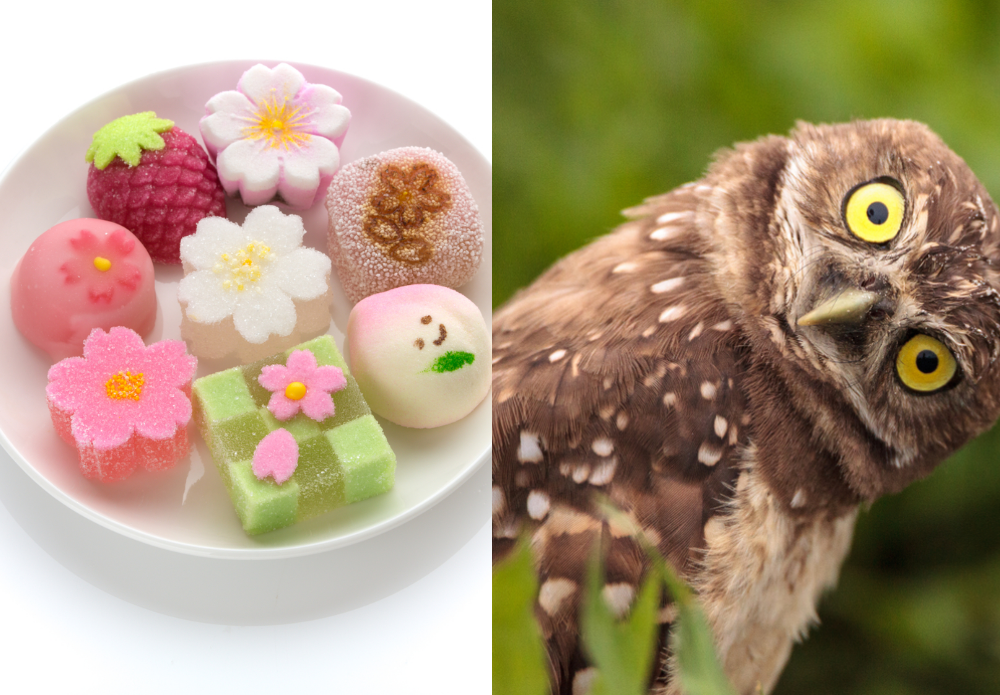Introduction

Japanese phonemes are both a blessing and a curse. Compared with English, Japanese introduces very little in the way of unfamiliar sounds. Many English speakers, given some time, can easily pronounce Japanese with only a minor English accent. However, due to this lack of variety in sound, there ends up being a large overlap between words. Homophones or near-homophones are extremely common in Japanese, and many words can only be distinguished through context, minor pronunciation differences, or in rare circumstances, tone. For the Japanese learner, this can be a nightmare!
To help those just beginning their study, we’ve put together a list of Japanese words that are commonly confused by beginners. From kawaii/kowai to ani/oni, note the differences and commit them to memory to avoid any embarrassing faux pas!
Words That Are Easily Confused
1. Kawaii / Kowai

“Kawaii” (かわいい) (kah-wah-ee-ee) is Japanese for cute or adorable. This is a very common word that you will see in many different contexts as Japanese culture loves everything and anything cute. However, be very careful when pronouncing the word.
猫が可愛いい (Neko ga kawaii) - [The] cat is cute
If you try and say it quickly, you may end up saying “kowai” (こわい) (koh-wah-ee) instead. Kowai means scary, afraid, or fearful, and it is also a relatively common word. When you see something cute, make sure to pronounce your “ka” and the extended “ii” sound or chance being very misunderstood!
猫が怖い (Neko ga kowai) - [The] cat is scary
There’s even another common kawaii-related mistake that is explained in number 7 below.
2. Suwaru / Sawaru

Only a single sound separates these two words. “Suwaru” (座る,すわる) (soo-wah-roo) means to sit down. Be it a chair, zabuton, or just on the ground, it doesn’t matter.
座ってください (Suwatte kudasai) - Please sit down
“Sawaru” (触る, さわる) (sah-wah-roo) on the other hand, means to touch or to feel. When offering someone a chair, make sure to pronounce the “su” loud and clear or risk making your guest feel understandably uncomfortable.
触ってください (Sawatte kudasai) - Please touch
3. Okusan / Okaasan

The differences between this pair are a bit less disastrous, but can still be cause for a fair bit of confusion. Okusan (奥さん, おくさん) (oh-koo-san) is a polite term for one’s wife. Okaasan (お母さん, おかあさん) (oh-kah-ah-san) is a polite term for one’s mother. The key here is in the second syllable: with wife, make sure you pronounce it “ku” while with mother, it’s a “ka,” with an elongated vowel sound.
私のお母さんです (Watashi no okaasan desu) - This is my mother
私の奥さんです (Watashi no okusan desu) - This is my wife
4. Okashi / Okashii

As noted in the introduction, Japanese as a language is lacking in the sound department. Compared to English, there’s a dearth of sounds that Japanese speakers can use to form words. As a result, many different words use the same sounds. This is where kanji become useful when reading. However, in spoken language, one can only rely upon context and very slight stresses to make sense between two different homophones.
The two words above are almost homophones, with a very slight difference. First, we have “okashi” (お菓子, おかし) (oh-kah-she), which means treat. This can be anything from cakes and cookies to rice crackers and little snacks.
お、お菓子! (O, okashi!) - Oh, sweets!
On the other hand, we have “okashii” (おかしい) (oh-kah-she-ee) which means strange or weird. You use it when something that should be working isn’t, or if something odd and unexpected is happening.
お、おかしい! (O, okashii!) - Oh, that's strange!
They are almost exactly the same word with the exception that okashii extends the “ii” sound ever so slightly. When something is weird, make sure to stress the “ii” sound at the end of the word, but when talking about sweets, keep it short and sweet!
5. Aru / Iru

As a language, Japanese is very keen to discern between things that are alive versus things that aren’t. When you are describing things that exist around you, it is key that you make that distinction or risk confusing whoever you are talking to. If something isn’t alive, for example a forest, you would need to attach “aru” (ある) (ah-roo) at the end of the sentence to describe it’s existence:
森がある (Mori ga aru) - "There is a forest"
On the other hand, say your friend Mori is right over there and you wanted to point him out in a relatively casual fashion, you might say:
森がいる (Mori ga iru) - "Mori's here"
In this case, “iru” marks Mori as a living being, and therefore a person’s name, as opposed to a forest. Aru/iru makes all the difference between pointing out your friend or remarking about trees. Although they don’t sound too much alike, it’s important to keep their distinction in mind and use them correctly when speaking.
6. Oni / Ani

Some may not make a distinction between these two, but it’s best to do so in polite company. First we have “oni” (鬼, おに) (oh-nee) which means devil or demon.
鬼がいる! (Oni ga iru!) - "It's a demon!"
Next we have “ani” (兄, あに) (ah-nee), big brother.
兄がいる!(Ani ga iru) - "I have an [older] brother!" (literally "there is a brother")
“Ani” is the casual form of the word “big brother,” used when referring to your own brother. Mix up the “a” with an “o” and you’ll be calling him a demon. It gets even more confusing, though:
The formal form of the Japanese word for “big brother” is “Onii-san” (お兄さん) (oh-nee-ee-san), used when talking to your own brother or when talking about someone else’s brother. This sounds even closer to “oni!” So, when referring to someone’s older brother, make sure to stretch the “ii” sound out so you don’t end up calling them a demon (although oni-san is quite a polite way to refer to a demon).
7. Kawaisou

A slightly more advanced mistake, this one involves grammar as compared to just sound. When learning how to build up Japanese words and sentences, learners are often introduced to the compound “sou” (そう). This is a suffix you can throw on the end of adjectives in order to express the observation “seems to.” For example, you might hear someone say:
おいしそう!(Oishisou!) - "That looks delicious!"
In this case, the person hasn’t tried the food yet, nor has anyone told them the flavor, but merely from the presentation alone they can gather that it seems like something they would eat. “Sou” is quite versatile, and you can use it in many different situations with many different adjectives.
However, upon seeing something adorable, one might be tempted to say:
かわいそう! (Kawaisou!) - "That seems cute!" ❌
What they’re actually saying is:
かわいそう! (Kawaisou!) - "How sad!" ✅
“Kawaisou” (可哀想) is an actual Japanese word that translates to “pitiful” or “sad.” Use it when you see a small child fall down in a puddle or when someone drops their sandwich. If you want to describe something as “seeming cute”, it’s better to use the compound “kawaii rashii” (可愛らしい).
False Friends
For the final three items, we’re going to look at some false friends or words that are known as “wasei eigo” (和製英語) meaning “Japanese-made English.” These are words that sound like English, talk like English, and may even walk like English, but have completely different meanings than their similar-sounding brethren. A lot of these words may originally derive from their English counterparts, but through their daily usage in Japanese have slowly drifted in meaning until they’re affixed to something completely different.
8. Konsento

In Japan, you don’t “konsento” (コンセント) to a form or a contract. Although it looks like the transliteration of the English word “consent,” a konsento is where you plug your charger in when your phone is running low. The term likely originated as an abbreviation of the term “concentric plug,” a fact that might help you keep this definition in your memory. Just don’t be alarmed when someone asks for your konsento—they may only be looking for somewhere to plug their laptop in.
9. Baikingu

This word is doubly dangerous. “Baikingu” (バイキング) can easily catch the English speaker off-guard. Some might hear “biking,” like “my hobbies are collecting Pokemon and biking.” Others, who know the Japanese trouble with the letter “V,” might instead imagine our ancient Norse friends in their giant warships. However, baikingu is neither biking nor Viking, but rather, it means “buffet.” This is because the first buffet-style restaurant to open in Japan was called the “Imperial Viking,” itself named after the 1958 American film “The Vikings,” which was popular at the time.
If you’re ever tempted to shorten it, don’t! Baikingu is all very well and innocent, but “baikin” (黴菌) means bacteria or germs!
10. Faito

One of the most commonly heard of the wasei eigo bunch, it’s also probably the easiest to misunderstand. You might find yourself one day hanging out with your Japanese friends before having to do something big, like give a presentation or take a test. They, through the most earnest of smiles, might raise up a fist and tell you to “faito!” (ファイト!). Contrary to what you might expect, your friend isn’t encouraging you to brawl with your audience or tackle the proctor, but rather, is telling you to do your best. It’s the wasei eigo equivalent of the classic Japanese cheer ganbatte (頑張って).
Committing These Differences to Heart

This list includes just the most common cases, but the more you study Japanese, the more you’ll come across homophones and tricky phrases like the above. However, miscommunications due to mispronounced words actually occur less frequently than you might imagine. When it comes to many similar-sounding words, they are often used in such different contexts that even if you mess up the sounds, most people will understand what you’re talking about and mentally fill in the correct words.
If you want to perfect your speech and never make the above mistakes, the best way to do so is to study and practice. Studying helps you make sure you know the differences, while practice will cement the correct sounds to the correct situations in your mind. The more you practice and the more you use the correct/words and grammar, the easier it will become to hear the differences between words and pronounce the words correctly when speaking.
No longer will “kawaii” sound like “kowai.” Cute and scary will become the two separate words they deserve to be.
Title image: meamorworks / Shutterstock
The information in this article is accurate at the time of publication.

